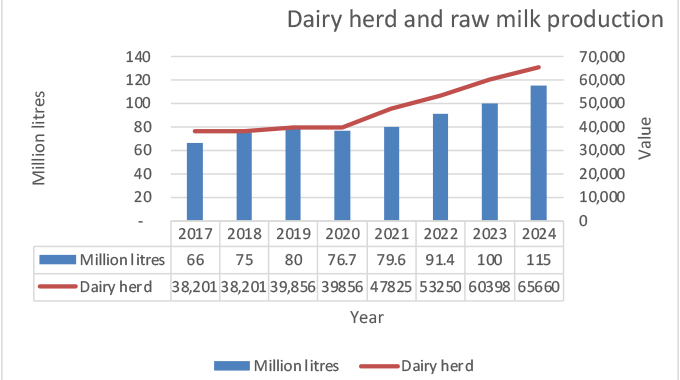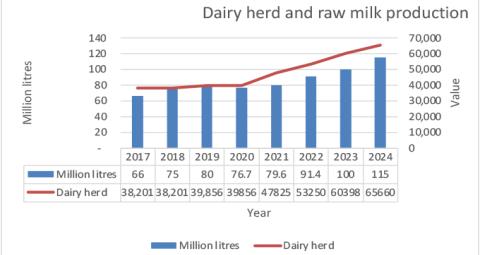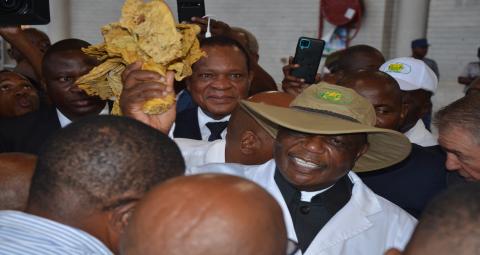
ZIMBABWE joined the rest of the world in celebrating the belated World Milk Day as the country moves to attain milk self-sufficiency from local production by year end.
The day is celebrated on June 1 of every year and was established by the Food and Agriculture Organisation of the United Nations (UN) to help people recognise the importance of milk as a global food and the dairy sector’s profound impact on society.
It was first celebrated in 2001.
This year’s celebrations are running under the theme: “Let’s celebrate the power of dairy.”
The Ministry of Lands, Agriculture, Fisheries, Water and Rural Development has since acknowledged that the dairy sector provides essential nutrients, supporting nutrition and health worldwide.
“It also contributes to economic resilience, supporting over one billion livelihoods globally. This year June 6 has been set aside for Zimbabwe to commemorate the day in Mutare, Manicaland Province,” said the Ministry.
The event is being hosted by the Department of Veterinary Services (DVS) and Zimbabwe Dairy Industry Trust (ZDIT).
The Ministry said this year’s celebrations aim to promote milk’s importance in nutrition, encourage milk consumption culture, highlight the dairy industry’s commitment to sustainability and impact on livelihoods as well as empower stakeholders to support access to nutritious foods.
Over eight years, the Zimbabwean dairy industry has recorded a 74 percent increase in raw milk production from 66 million litres in 2017 to 115 litres last year.
The dairy herd has also increased 72 percent over the same period.
The nation requires 131 million litres of milk for self-sufficiency and from last year’s production of 115 million litres, an additional 16 million litres need to be added to achieve the self-sufficiency goal.
Stakeholders in the industry are targeting a 15 percent increase in raw milk output this year to 132 million litres.
Statistics released by the Dairy Services Unit (DSU) recently showed that raw milk production increased four percent from 36 348 019 litres in the first four months of 2024 to 37 659 006 in the comparable period this year.
Government, private sector and development partners have been supporting national herd growth through breeding support, ensuring access to hybrid semen and vaccines, pasture development through input support programmes for all classes of dairy farmers as well as through support in prioritisation of power to dairy farmers to maintain cold chain.
Presenting the 2023 national budget, Finance, Economic Development and Investment Promotion Minister, Professor Mthuli Ncube said: “In order to augment local production, and also cognisant of the need to provide the local industry ample time to invest in the necessary infrastructure and dairy herd, Government has, over the years, suspended duty on imported milk powder.
“Furthermore, in order to enhance self-sufficiency in milk production, Government introduced a levy of five percent on the value of imported dairy products with effect from January 2022. The funds are ring-fenced towards re-capitalising the Dairy Revitalisation Fund, which is targeted at growth and development of the dairy sector by increasing the national dairy herd, as well as enhancing competitiveness of the sector.”
He urged dairy processors to increase support to out-grower schemes, with a view to build the stock of dairy herd towards self-sufficiency in raw milk production and demonstrate their gratitude for the measure Government is implementing to discourage imports.
Prof Ncube said in line with the objectives of National Development Strategy 1 (NDS1), there was need to gradually substitute imports through increased production, coupled with simultaneous increase in the uptake of raw milk by processing companies from 70 million litres to 130 million per annum by 2025.
The Government then gradually reduce ring-fenced milk powder imports under suspension of duty as follows:
The effects of these fiscal measures are bearing fruit as milk product imports dropped 16 percent from US$37 million in 2021 to US$31 million in 2022. In 2023, a 15 percent drop to US$27 million was also recorded. It continued on the downward trajectory with another 23 percent plunge to US$20 million in 2024.




